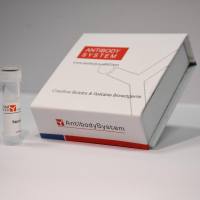Defining In Vivo Targets of Nuclear Proteins by Chromatin Immunoprecipitation and Microarray Analysis
互联网
- Abstract
- Table of Contents
- Materials
- Literature Cited
Abstract
This unit describes the combination of chromatin immunoprecipitation (ChIP) with microarray hybridization to determine the genome?wide occupancy profile of a DNA?associated protein. After conventional ChIP, the immunoprecipitated material is amplified by a two?step process involving primer extension followed by PCR in the presence of a modified nucleotide. The amplified DNA is fluorescently labeled in a reaction that couples dye to the modified nucleotide, and the labeled sample is hybridized to a microarray representing a complete genome. This method allows the study of a protein's pattern of DNA association across an entire genome with no need for prior knowledge of potential DNA targets.
Keywords: Chromatin immunoprecipitation; ChIP; microarray; amplification; PCR; dye coupling; protein?DNA interactions; ChIP?chip; ChIP?on?chip; genome?wide location; hybridization; whole?genome analysis
Table of Contents
- Reagents and Solutions
- Commentary
- Literature Cited
Materials
Basic Protocol 1:
Materials
|
Figures
Videos
Literature Cited
| Literature Cited | |
| Bohlander, S.K., Espinosa, R. III, Le Beau, M.M., Rowley, J.D., and Diaz, M.O. 1992. A method for the rapid sequence‐independent amplification of microdissected chromosomal material. Genomics 13:1322‐1324. | |
| DeRisi, J., Penland, L., Brown, P.O., Bittner, M.L., Meltzer, P.S., Ray, M., Chen, Y., Su, Y.A., and Trent, J.M. 1996. Use of a cDNA microarray to analyse gene expression patterns in human cancer. Nature Genet. 14:457‐460. | |
| DeRisi, J.L., Iyer, V.R., and Brown, P.O. 1997. Exploring the metabolic and genetic control of gene expression on a genomic scale. Science 278:680‐686. | |
| Eberwine, J. 1996. Amplification of mRNA populations using aRNA generated from immobilized oligo(dT)‐T7 primed cDNA. BioTechniques 20:584‐591. | |
| Iyer, V.R., Horak, C.E., Scafe, C.S., Botstein, D., Snyder, M., and Brown, P.O. 2001. Genomic binding sites of the yeast cell‐cycle transcription factors SBF and MBF. Nature 409:533‐538. | |
| Kuras, L. and Struhl, K. 1999. Binding of TBP to promoters in vivo is stimulated by activators and requires Pol II holoenzyme. Nature 399:609‐613. | |
| Lee, T.I., Rinaldi, N.J., Robert, F., Odom, D.T., Bar‐Joseph, Z., Gerber, G.K., Hannett, N.M., Harbison, C.T., Thompson, C.M., Simon, I., Zeitlinger, J., Jennings, E.G., Murray, H.L., Gordon, D.B., Ren, B., Wyrick, J.J., Tagne, J.B., Volkert, T.L., Fraenkel, E., Gifford, D.K., and Young, R.A. 2002. Transcriptional regulatory networks in Saccharomyces cerevisiae. Science 298:799‐804. | |
| Li, X.Y., Virbasius, A., Zhu, X., and Green, M.R. 1999. Enhancement of TBP binding by activators and general transcription factors. Nature 399:605‐609. | |
| Lockhart, D.J., Dong, H., Byrne, M.C., Follettie, M.T., Gallo, M.V., Chee, M.S., Mittmann, M., Wang, C., Kobayashi, M., Horton, H., and Brown, E.L. 1996. Expression monitoring by hybridization to high‐density oligonucleotide arrays. Nat. Biotechnol. 14:1675‐1680. | |
| Moqtaderi, Z. and Struhl, K. 2004. Genome‐wide occupancy profile of the RNA polymerase III machinery in Saccharomyces cerevisiae reveals loci with incomplete transcription complexes. Mol. Cell. Biol. 24:4118‐4127. | |
| Reid, J.L., Iyer, V.R., Brown, P.O., and Struhl, K. 2000. Coordinate regulation of yeast ribosomal protein genes is associated with targeted recruitment of Esa1 histone acetylase. Mol. Cell. 6:1297‐1307. |









